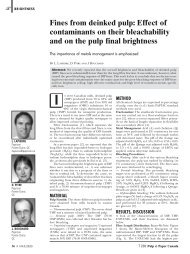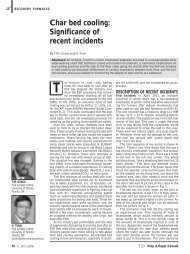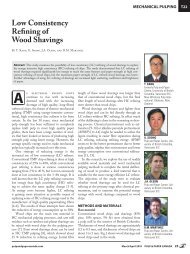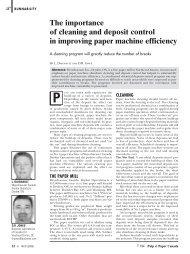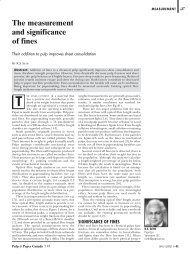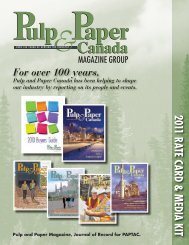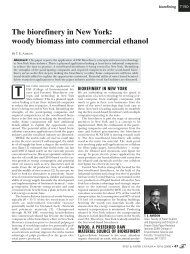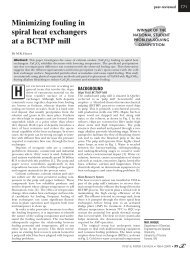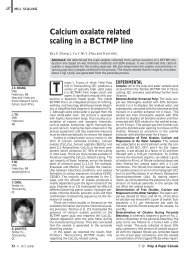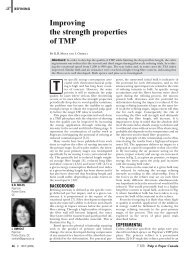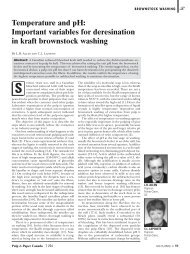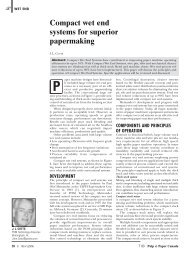Potential of refining and dispersing to develop recycled fibre properties
Potential of refining and dispersing to develop recycled fibre properties
Potential of refining and dispersing to develop recycled fibre properties
Create successful ePaper yourself
Turn your PDF publications into a flip-book with our unique Google optimized e-Paper software.
ecyclingT38widely from one country <strong>to</strong> another, theoptimum technology may differ with thedeinking plant location as well as withtime.The combination <strong>of</strong> HC treatment <strong>and</strong>LC <strong>refining</strong> in series could lead <strong>to</strong> apromising final result, as suggested by Fujita/ Aikawa investigations in Japan [10].Finally, a new technology should be<strong>develop</strong>ed <strong>to</strong> limit the detrimental effects<strong>of</strong> <strong>refining</strong>, mainly <strong>fibre</strong> cutting. Since it isclear that <strong>refining</strong> <strong>of</strong> <strong>fibre</strong> mixtures willnever give the best <strong>develop</strong>ment for either<strong>fibre</strong> [11], fractionation <strong>and</strong> selective<strong>refining</strong> <strong>of</strong> coarse mechanical <strong>fibre</strong>s couldshow the way.ACKNOWLEDGEMENTSThe authors wish <strong>to</strong> thank their colleaguesKatharina Renner, WolfgangSpiess, Marko Lesiak, Harald Michels, StefanWinkelbauer, Klaus Müller-Gommert<strong>and</strong> Wolfgang Krodel for their collaborationin this study. A special thank <strong>to</strong> JaanaLumpiola <strong>and</strong> Sinikka Seppanen for performingthe labora<strong>to</strong>ry work with excellentreliability.REFERENCES1. MOHLIN, U-B., MILLER, J. Influence <strong>of</strong> industrialbeating on swelling <strong>and</strong> <strong>fibre</strong> shape. Proc. AticelcaNew available techniques <strong>and</strong> current trends 4th internationalconference. Bologna Italy (1992).2. LUMIAINEN, J. Refining <strong>of</strong> deinked pulp formechanical printing papers. Sunds Defibra<strong>to</strong>r.3. LUMIAINEN, J. Refining - a key <strong>to</strong> upgrading thepapermaking potential <strong>of</strong> <strong>recycled</strong> <strong>fibre</strong>. Paper Technology35(7): 41- 44(1994).4. LUMIAINEN, J. Refining <strong>recycled</strong> <strong>fibre</strong>s: advantages<strong>and</strong> disadvantages. Recycling: A TAPPI PRESSAnthology <strong>of</strong> published papers. Chapter 4 Deinking uni<strong>to</strong>perations. Tappi Press (1997).5. LJUNGKVIST, K. Pulp characterization by permeabilitymeasurements. Chalmers University <strong>of</strong> Technology.Goteborg, Sweden (1983).6. KRIEBEL, A.; SIGL, R. The influence <strong>of</strong> disk <strong>and</strong>kneading dispergers on <strong>fibre</strong> <strong>properties</strong>. Voith Paper.7. WESTON, J.D.W., GUEST, D.A. The importance <strong>of</strong>Cell wall structure in recycling <strong>fibre</strong>s. Paper Technology<strong>and</strong> Industry 26(7): 309-317(1985).8. KOLJONEN, T., HEIKKURINEN, A. Characterization<strong>of</strong> <strong>refining</strong> effects on deinked pulp. Proc. PTSDeinking Symposium (1994).9. POUSI, J. Post <strong>refining</strong> <strong>of</strong> <strong>recycled</strong> <strong>fibre</strong>s. Comparison<strong>of</strong> the effect <strong>of</strong> HC <strong>and</strong> LC post-<strong>refining</strong> on the<strong>recycled</strong> <strong>fibre</strong>s. Metso (2003).10. FUJITA, K. How <strong>to</strong> improve secondary fiber characteristicsfor paper board: report on recent trend <strong>and</strong>recent <strong>refining</strong> technologies for OCC treatment. Proc.3rd CTP PTS Packaging Paper <strong>and</strong> Board Recyclinginternational symposium, CTP Grenoble, France(2004).11. BAKER, C. Advances in different <strong>refining</strong> methodsparticularly <strong>refining</strong> <strong>of</strong> mixtures. The 6th Pirainternational <strong>refining</strong> conference. Toron<strong>to</strong> (2001).Résumé: Nous avons caractérisé la performance du raffinage des <strong>fibre</strong>s recyclées en terme de coupedes <strong>fibre</strong>s, élimination de la paroi, fibrillation externe et interne, création d’éléments fins et diminution ducurl et des coudes. La spécificité du raffinage haute concentration (HC) par rapport au raffinage basseconcentration (LC) est la fibrillation interne et une coupe de <strong>fibre</strong> limitée. Un disperser diffère d’un raffineurde part l’augmentation du curl et des coudes. Comme attendu, le raffinage basse concentrationaméliore état de surface du papier, brillant, porosité, résistance à la rupture, mais dégrade main et résistanceà la déchirure. En outre, le raffinage HC <strong>of</strong>fre plus de possibilités de développer les propriétés derésistance du papier.Reference: LE NY, C., MESSMER, M. <strong>Potential</strong> <strong>of</strong> <strong>refining</strong> <strong>and</strong> <strong>dispersing</strong> <strong>to</strong> <strong>develop</strong> <strong>recycled</strong><strong>fibre</strong> <strong>properties</strong>. Pulp & Paper Canada 108(2): T35-38 (February, 2007). Paper presented at theRecycling Conference 2004 in Quebec, QC, September 27 - 29, 2004. Not <strong>to</strong> be reproduced withoutpermission <strong>of</strong> PAPTAC. Manuscript received July 08, 2004. Revised manuscript approved forpublication by the Review Panel July 24, 2006.Keywords: RECLAIMED FIBERS, REFINING, CONSISTENCY, FIBRILLATION, PAPERPROPERTIES.PULP & PAPER CANADA • 108:2 (2007) • 41




